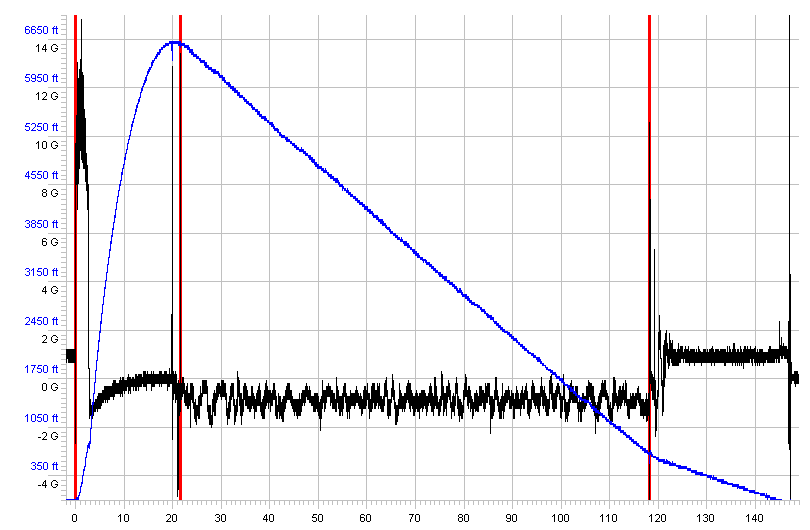
Here is the RDAS accleration and pressure data for the entire flight. I recorded 6 analog channels and the discrete data at 200 samples/second. The analog data was: acceleration, pressure, magnetic field (three axis), and magnetic sensor voltage reference.

Next is the data to just past apogee.

The AltAcc firing its ejection charge is clearly visible in both the acceleration and pressure data. I suspect that since my electronics bay is not epoxyed into the airframe that some of the ejections gasses are getting through the space between the airframe and the coupler the electronics bay is built from. I will try putting a bit of tape on the bay to try and tighten up the seal on the next flight.
I do not know what caused the dip in pressure altitude at three seconds. This flight did not have the extreme pitch oscillations that it had on the K560 so something else must have done it. I haven't exactly vented my altimeter bay very well since both altimeters are accelerometer based. Maybe it is time to drill some more holes.
I processed the pressure data recorded by the RDAS using a third order Kalman filter. This filter uses a constant acceleration model of the vehicles flight combined with the pressure and acceleration data to estimate the position (altitude), velocity and acceleration of the rocket.
The Kalman filter program processes the exported interpreted data from the RDAS program and outputs another text file with all of the data. I then used GNUPlot to create the plots.
The first plot shows the altitude from just before liftoff till after apogee. The noisy green line is the unfiltered altitude data from the RDAS data file.

The pressure data has a slight wiggle in it right at motor burnout. I have no idea what caused this and it also showed up in the AltAcc data. Good thing this wasn't a simple barometric altimeter as it would have fired the apogee charge at maximum velocity. The velocity estimate is really, really bad during this wiggle. But things settle out and by apogee it is doing very well again.
The next plot is the same thing but zoomed in to the time around apogee. The acceleration spike at 19.8 seconds is caused by the other altimeter (an AltAcc) firing.
